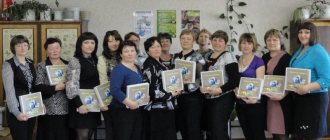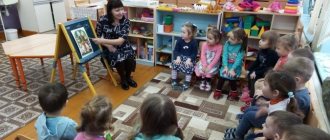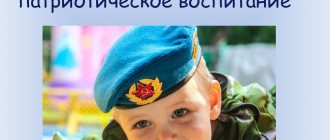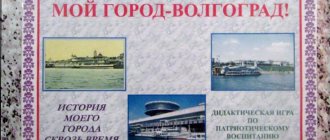Entertainment for the moral and patriotic education of children in the preparatory group
Quiz game “If you have seen Kamchatka, you will never forget”
Author: Tatyana Petrovna Buruyan, teacher Place of work: MBDOU “Kindergarten No. 1”, Kamchatka Territory, Vilyuchinsk Description of the material: Kamchatka is a distant, fabulous and extraordinary region. Kamchatka, hills and volcanoes, Lakes, tundra and bear The ship fills the net with red fish from the ocean. In its northern expanses, a herd of deer grazes and the trail from the sleigh goes into the distance like a white ribbon on a clear day. And if you saw this, You will never forget, Kamchatka, hills and volcanoes remain in your soul forever. A. V. Sokolov I bring to your attention an entertainment scenario for children of the preparatory group, to consolidate knowledge about Kamchatka in the quiz game “If you have seen Kamchatka, you will never forget.” This methodological development is aimed at nurturing moral and patriotic personality traits in children, at consolidating comprehensive knowledge about their native land, love and respect for it. The methodological development of the lesson is available in practical application and can be used in pedagogical practice by teachers of preschool educational institutions for the moral and patriotic education of children. Entertainment for the moral and patriotic education of children in the preparatory group Quiz game “If you’ve seen Kamchatka, you’ll never forget” Types of children’s activities: playful, productive, communicative, cognitive-research, perception of fiction. Goals: consolidate children’s knowledge about their native land, actively support proactive statements on quiz questions; existing knowledge, independent judgment; respond to your partner’s statement; cultivate curiosity and interest in their homeland - Russia. Objectives: Educational:
consolidating children’s knowledge about the region, attractions, and nature through various types of activities.
Developmental:
develop moral and patriotic qualities: pride, humanism, the desire to preserve and increase the wealth of the region, develop children’s coherent speech, enrich their vocabulary.
Promote the development of memory and thinking. Educational:
to cultivate feelings of love and pride for one’s small homeland;
cultivate a kind, respectful attitude towards your city, streets, monuments. Preliminary work: conducting thematic classes to familiarize children with the region; learning folk games, songs, poems, dance; conversations with children about the region; reviewing books about Kamchatka; viewing photographs “Volcanoes”, “Fauna of Kamchatka”, etc.; excursion to a local history museum, library, etc.; writing creative stories on the topic “My land is Kamchatka. Materials and equipment: cut coats of arms of Kamchatka and the city of Vilyuchinsk; deer antlers, rings; stars; audio recording for the dance “Reindeer Herders and Reindeer”; illustrations, photographs, children's works, backing tracks for the song “Song of the Deer Land”; medals for each child. Planned results: as a result of the event, children showed their knowledge about their native land, formulated answers to questions, showed activity and interest in the history of their native land. Progress of the entertainment Children to the music of a waltz, children enter the group, perform simple dance movements and stand scattered. Child. Oh, Kamchatka! You are simply amazing! Picture 1.
You are an inflorescence of ice and fire, graceful, wise and beautiful, you are a witch and my fairy tale!
Child. Oh, Kamchatka! You are strong in storms, snowfalls and people. Oh, Kamchatka! You are with us everywhere, both in celebration and in love. Child. Oh, Kamchatka! You are the heart of Russia. After all, you are woven from our hearts. You give us hope and strength, You, like a swan, are sweet and faithful. Child. We are your sons, dear children, You must take care of us and understand us, So that the golden rays can embrace us with a motherly smile! Children sit on chairs. A boy and a girl come out. Dialogue between 2 children. Figure 2.
Girl. How I would like to see my Motherland now. Boy. Oh, you see her every day. Girl. But where is she? Boy. And look around, what do you see? Girl . Our group. Boy. That’s right, the Motherland begins precisely with our group, with our parents’ porch, with our mother’s cradle. The children take their seats. Educator. Motherland! They write and talk about her a lot. What do you think, what is the Motherland? Children. This is the place where we were born, where we live, where we go to kindergarten, where our mothers, fathers, and friends live. The Motherland is our home, our hometown, our region. Educator. Every person loves his homeland, the city in which he lives. You can only love what you know well. The more we know about our region, the more we will love it. Today we will continue our journey through an amazing corner of our Earth called... Children. Kamchatka. There is a knock on the door. Grandfather Local historian enters. Figure 3.
Grandfather Local historian. Hello guys. I, Grandfather Local historian, know everything, I know everything about my native land, about Kamchatka. I heard that you know a lot about your region, so I want to check if this is true. Educator. It's good that you, grandpa, came to us. Today we have a game in which the guys will show their knowledge about the region. Well, I invite you guys to a game - a quiz “If you have seen Kamchatka, you will never forget.” Please take a seat at the tables. I represent our wonderful teams and their captains: 1 team - “Bear Cubs”, captain - Sasha Kozhevnikova; Team 2 - “Fawns”, captain - Anastasia Demchenko. Grandfather Local historian. Be careful during the game and listen to the questions. For each correct answer you will receive these stars. Figure 4.
If a team does not answer a question, then the right to answer passes to another team.
And when summing up the results, I will reward the winning team. Educator. And so, let's begin! Kamchatka is a native, beloved land, harsh, but unique. You beckon into the distance with your greatness, White volcanoes with indifference. — This is how poets glorify the beauty of Kamchatka in their poems. Let's see if our teams can cope with this. Educator. I am announcing 1st competition - “The Beauty of Kamchatka in Poems” - teams need to beautifully read poems about Kamchatka. Let's listen to the children of the Bears team. Child. I live at the edge of the earth Figure 5.
A corner dear to my heart, In the morning I see how the Hills turn red, looking to the East. I hear the Wise Pacific Ocean sigh heavily. I am proud of you, Kamchatka, I am proud that Kamchadal.
Child. Among the high rushing mountains Among the wise volcanoes I stood, looking at the East of our Kamchatka Bay. Child. There are many different wonderful secrets here. All the power of nature is here, And the waves rush straight into the ocean hastily. Child. Look into the sky and you will see. Like cotton wool clouds And between them so beautifully A seagull circles from above. Educator. Thanks guys. They did an excellent job. Now let’s listen to the guys from the “Deer” team. Child. Kamchatka is a lovely land of volcanoes, And the swaying of the earth, And the vast expanse of the ocean - Accept a declaration of love. Child. I love the azure of the high skies, the steepness of the curly hills, the bends of the rivers, so deep, the crystal clear lakes. Child. In the distance, the volcano is calm and majestic, straightening its shoulders in the gray cap of clouds. Gray strands of snow scattered, Falls on the stone chest. Child. You are beautiful in winter and summer, my dear Kamchatka! And it’s not in vain I love you so much! Educator. Well, the guys performed wonderfully and both teams receive an asterisk. Each country has its own state symbols. Tell me which ones? Child. Flag, coat of arms, anthem. Educator. That's right, guys. I am announcing the next competition “Collect a symbol of the Kamchatka Territory and the city of Vilyuchinsk.” Each team makes up the coat of arms of the Kamchatka Territory and the coat of arms of the city of Vilyuchinsk from separate parts, and stands at the tables. Figure 6.
Educator. Team "Bears", what symbol have you collected? Child. This is the coat of arms of Kamchatka. Figure 7.
Educator. Tell us about it. Children. Children talk about the coat of arms.
The coat of arms of Kamchatka depicts three volcanoes, with red smoke coming out of each peak.
The rising sun is depicted behind the volcanoes. Around the sun there is a Kamchatka ornament. Educator. Team "Deer", what symbol have you collected? What can you tell us about him? Children. Figure 8.
This is the coat of arms of our city Vilyuchinsk.
It is blue in the center with an anchor with laurel branches, and two dirks below. The blue color is the endless ocean on the shores of which the city is located. Crossed dirks mean protection, courage, heroism, and courage of people. The laurel wreath is a symbol of the greatness of the Russian Navy. The anchor symbolizes the navy. Educator. So, the teams completed the next task. And they get a star. And I announce the beginning of the next competition. The competition is difficult, be careful! Grandfather Local historian. The next competition is “Discoverers of Kamchatka”. A long time ago, when exactly no one knows, each nation composed its own fairy tales. Every nation loves and cherishes its fairy tales. Teams, who would like to tell one of these tales and get a star? A kid from the team. This tale was invented by the Koryaks. This happened in ancient times. One day the magician raven Kutkinyaku was flying over big water - over the sea or ocean. I was flying and very tired. Where to relax? There is water all around. Then the raven folded his wings and fell into the sea. He dived deep, deep and pulled out a huge stone. I sat on it and rested. This stone was a large land, which Kutkinyaku pulled out of the great water from the whole region. Educator. Okay, we've told you a fairy tale, here's an asterisk. Yes, the Koryaks came up with a wonderful fairy tale. They believed that the raven Kutkinyak created dogs, deer, whales, and birds. And yet, who discovered Kamchatka? There is a chance for the guys from the other team to get a star. Child. A long time ago, when the Russian Cossacks visited Anadyr, they heard that in the south there was a “Big Nose” (the nose is a piece of land, which was later called Kamchatka)
.
The first Russian to see Kamchatka was Mikhail Stadukhin. Educator. Well done! Here's an asterisk for you. The opposing team can continue. Who else has visited Kamchatka? Child. Then, 10 years later, several Russian Cossacks managed to penetrate these lands. They were: Ivan Rubets, Fyodor Laptev, Monty Fedotov. But before all the others there was Ivan Ivanov, nicknamed “Kamchatoy”, from which the name of the river, and then the entire peninsula, came. But for some reason, some are silent about these travelers. Grandfather Local historian. Well done guys, get your star. Yes, indeed, we have practically never heard the names of these people. Which pioneers have we already talked about? The opposing team answers. Child. Some discoveries were made by Cossack Vladimir Atlasov. Having traveled a long way from the edge of Siberia to the south, he installed a wooden cross on the banks of the Kamchatka River, which became a symbol of the annexation of the peninsula to the mainland. Educator. The answer is correct and the team gets a flag. What will your rivals add? Child. Stepan Krasheninnikov also belongs to the discoverers of Kamchatka. He traveled around Kamchatka alone and made many conclusions and observations. Educator. Yes, guys, these are the people who discovered Kamchatka by land. Who was the first to arrive here on a ship? Child. While Krasheninnikov was traveling alone in Kamchatka, two packet boats, “St. Peter” and “St. Paul,” were built in Okhotsk. Soon they sailed to Kamchatka and dropped anchor in Avacha Bay. This is where the Peter and Paul port was founded by Vitus Bering. Educator. That's right, guys. It later became the city of Petropavlovsk-Kamchatsky. Educator. Yes, these are people who made a great contribution to the development of Kamchatka. And so, another competition ended. The teams have a lot of stars. But now, I suggest you rest a little. Our native land conceals many unsolved secrets. Guess the riddle. Who covers the distance under the northern lights? Who has branchy horns? The legs are thin, the legs are fast? In the white tundra, the fastest, Who is he? Children. Reindeer. Educator. Come out. Let's sing the song of the deer land. Children sing the song “Song of the Deer Land” Figure 9.
sl.
V. Gudimova, music. G. Novgorodova 1. The wind is spinning in the birch grove, And in the sky the lark is singing. You are my most beloved land in the world, Your bright image lives in me. Chorus:
You grow and flourish, my native deer land.
You grow and flourish, my native deer land. 2.The mountain is centuries old. A herd of deer, White Siberian Cranes fly into the distance... A hundred generations have seen the mountain here, And under the mountain there is a wonderful treasure. After the song is performed, the children take their places. 4 boys put on reindeer hats. Educator. Hey guys, the deer are coming. Boys come out - reindeer herders, dressed in Koryak costumes and boys in reindeer hats. A Koryak melody sounds. Dance of deer and reindeer herders. Figure 10.
Educator. A beautiful, fleet-footed animal, also a faithful assistant to the northern peoples - the Yakuts, Evenks, Chukchis, hardy and seasoned people. Harnessing a reindeer to a sled, they cover long distances, and they sew warm clothes from the reindeer skin. To catch him, you need to be dexterous, fast, and accurate. Grandfather Local historian. Are you as dexterous and accurate? So let's try to catch the deer by the horns. Game “Throwing a lasso” Deer antlers are attached to the stand. Children put rings on the antlers from a distance. Who will hit the target more accurately? Figure 11.
Educator. But it’s not just reindeer herders who catch deer. There are many wild animals in the forests that hunt deer. Who do you think it is? Children. Wolves. Educator. That's right, these are wolves - a thunderstorm for deer. Let's see if the wolf can catch our deer? Game “Wolf and Deer” Figure 12.
Two ropes (ditch) are laid out at a distance of 1 m. The wolf “walks” along the moat, catching children who are trying to jump over the moat. Educator. Well, the teams had a little rest. And I announce the beginning of the final competition, the Questions and Answers competition. Teams take turns answering questions. If a team does not know the answer to a question, another team answers that question. For correct answers, teams receive stars. Educator. Question for the “Bears” team: name the volcanoes of our peninsula? Children. Kronotsky, Koryaksky, Avachinsky, Vilyuchinsky, Tolbachik, Bezymyanny, Gorely, Ushakovsky, Komarova, Zheltovsky, Sheveluch, Klyuchevskoy, Mutnovsky, etc. Educator . Question for the Oleni team: name the indigenous people of Kamchatka? Children. Koryaks, Itelmens, Evens, Aleuts, Ainu. Educator. What do Koryaks do? Children. The Koryaks are talented and hardworking people. Men compete with each other to catch animals, birds, furs, and fish. They also compete in reindeer sled races and in the skill of catching deer in a herd. Educator. What do Koryakh women do? Child. And Koryak women compete in their ability to run a house, run a household, and especially in the art of sewing and decorating fur products. The Koryaks are masters of fur products. Women also make souvenirs. These souvenirs are made of leather, suede, reindeer fur and beautifully decorated by the hands of Koryak craftswomen. Educator. What is the name of Koryak outerwear and what is it made of? Children. Koryak outerwear is called kukhlyanka. It is made from the skins of reindeer calves. Decorated with beads and suede, camus. Camus is a particularly durable and warm skin on the legs of reindeer. The hem is decorated with an ornament of dark and light fur. Educator. Look at the picture, what is shown in it? Figure 13.
Children. This is a torbasa! Torbasa are Koryak shoes, they are sewn from reindeer fur or suede. Decorated with beads or kamus. Educator. And what's that? (shows a picture). Child. This is a headdress called malakhai. The malakhai hat is made from kamus, and the skins of dogs, arctic foxes, and wolves are used for the edges. Educator. The nature of Kamchatka is rich and diverse. Name the waterfowl of our peninsula? Children. Ducks, geese, cormorants, gulls, whooper swans. Educator. Name the birds that are listed in the Red Book? Children. Steller's sea eagle, white-tailed eagle, peregrine falcon. Educator. Name the animals of Kamchatka that you know? Children. Brown bear, East Siberian elk, brown hare, bighorn sheep. polar wolf, reindeer, lynx, wolverine. Educator. Name the fish that inhabit the reservoirs of Kamchatka? Children. These are chinook salmon, coho salmon, sockeye salmon, whale, pink salmon, masu salmon, greenling, navaga, herring, flounder, capelin, smelt, pollock. Educator. The final “Questions and Answers” competition has ended. And we will summarize. Grandfather, please count how many stars the “Bear Cubs” team received, and I will count the number of stars for the “Fawns” team. Team stars are counted. Summing up. Educator. Our game has come to an end - the quiz “If you’ve seen Kamchatka, you’ll never forget.” Grandfather Local historian. And for the winning team, I prepared these “Experts of the Native Land” medals. Presentation of medals for winning the game - quiz.
Educator.
Let's take a photo to commemorate our journey through our native land. Figure 14.
Calm music sounds. Children leave the group. Literature used: 1. “Acquaintance with your hometown as a means of patriotic education.” Rybalkova I. // Preschool education 2003, No. 6. P. 45 - 55. 2. “Comprehensive classes for the development of creative abilities of preschoolers” HB Korchanovskaya “Phoenix” Rostov-on-Don 2004 3. “Education of civic and patriotic feelings in a child of senior preschool age.” Yakusheva T. A. // Preschool pedagogy 2006, No. 6. 4. Patriotic education of preschoolers N.V. Aleshina T.G.L. Moscow 2005 5. Classes on patriotic education at preschool educational institutions. Ed. L. A. Kondrykinskaya. – M.: TC Sfera, 2010. – 160 p. 6. N.V. Aleshina. Introducing preschoolers to their hometown and country. – M. TC “Perspective”, 2011. – 296 p. 7. M. D. Makhaneva. Moral and patriotic education of preschool children. Toolkit. - M.: TC Sfera, 2010. - 96 p.
We recommend watching:
Raising patriotic feelings in older preschoolers Project for children 6-9 years old “What’s in your name...” Project at a preschool educational institution. Patriotic education of preschool children Patriotic education of preschool children
Similar articles:
Conversation about the Constitution for older preschoolers
Conversation about the President of Russia in the senior group
About spiritual teachers for children
Thematic conversation for children of the senior preparatory group “Commanders and Heroes”
Conversation for children 5-8 years old. Russia is proud of them




